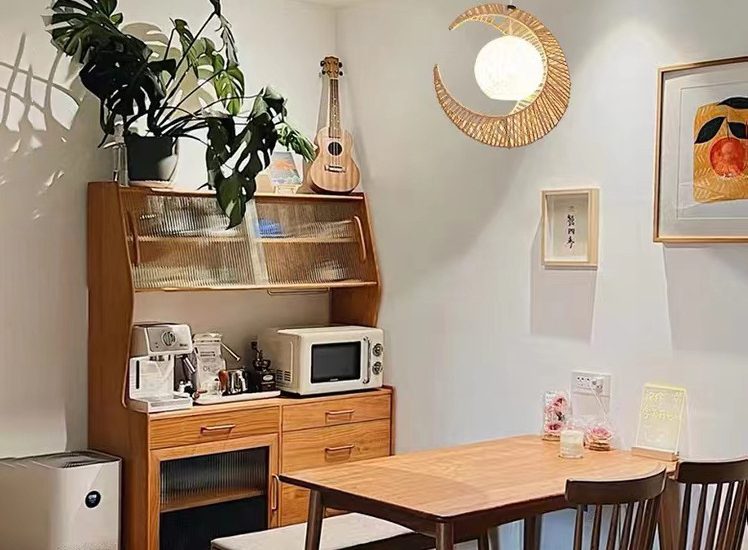When it comes to designing a kitchen, lighting is often an overlooked aspect. However, good lighting is essential for creating a functional and stylish space. It not only helps you see what you’re doing but also sets the mood, enhances productivity, and ensures safety in the kitchen.
Proper lighting in the kitchen is crucial for performing tasks such as chopping vegetables, reading recipes, and cooking meals. It helps you see clearly and prevents accidents or injuries that can occur due to poor visibility. Additionally, good lighting can improve your mood and make your kitchen a more inviting space to spend time in.
Types of Lighting: Understanding the Different Options Available
There are three main types of lighting that are commonly used in kitchens: ambient lighting, task lighting, and accent lighting.
Ambient lighting provides overall illumination to the entire space. It is usually achieved through ceiling-mounted fixtures such as recessed lights or flush-mount fixtures. Ambient lighting should be bright enough to ensure visibility but not too harsh or glaring. Housetonlighting
Task lighting is focused on specific areas where tasks are performed, such as countertops, stovetops, and sinks. It helps provide adequate light for activities like food preparation and cooking. Task lighting can be achieved through under cabinet lights, pendant lights, or track lighting.
Accent lighting is used to highlight specific features or objects in the kitchen, such as artwork or architectural details. It adds depth and visual interest to the space. Accent lighting can be achieved through spotlights, track lights, or wall sconces.
Pendant Lights: Adding Style and Functionality to Your Kitchen
Pendant lights are a popular choice for kitchens because they add both style and functionality to the space. They come in a variety of sizes, styles, and materials, making it easy to find one that suits your kitchen’s aesthetic.
Pendant lights can be used as task lighting above kitchen islands or dining tables, providing focused light for activities such as food preparation or dining. They can also be used as ambient lighting when placed strategically throughout the kitchen.
When choosing pendant lights for your kitchen, consider the size and style of your space. For smaller kitchens, opt for smaller pendant lights that won’t overwhelm the space. For larger kitchens, you can go for larger pendant lights or even a cluster of smaller ones to create a statement.
Installation of pendant lights in the kitchen requires careful consideration of the height and placement. The height of the pendant lights should be adjusted so that they provide adequate lighting without obstructing the view or causing glare. It is also important to ensure that they are installed securely and safely.
Under Cabinet Lighting: Illuminating Your Countertops and Workspaces
Under cabinet lighting is a practical and stylish way to illuminate your countertops and workspaces in the kitchen. It provides direct light where you need it most, making it easier to see what you’re doing while preparing meals or working on other tasks.
There are several types of under cabinet lighting options available, including LED strip lights, puck lights, and linear lights. LED strip lights are a popular choice because they are energy-efficient, long-lasting, and provide even illumination. Puck lights are small, round fixtures that can be installed individually or in a series. Linear lights are slim, tube-like fixtures that can be mounted under cabinets for a sleek look.
When installing under cabinet lighting, it is important to consider the placement and spacing of the fixtures. They should be positioned in such a way that they provide even illumination across the entire countertop. Additionally, it is important to ensure that the wiring is hidden and that the fixtures are securely attached to the cabinets.
Chandeliers and Ceiling Fixtures: Creating a Focal Point in Your Kitchen
Chandeliers and ceiling fixtures are not typically associated with kitchens, but they can add a touch of elegance and create a focal point in the space. They can be used to enhance the overall design and style of the kitchen, making it feel more luxurious and sophisticated.
When choosing a chandelier or ceiling fixture for your kitchen, consider the size and style of your space. A large chandelier can make a statement in a spacious kitchen with high ceilings, while a smaller fixture may be more suitable for a smaller kitchen. The style of the chandelier or ceiling fixture should also complement the overall design aesthetic of the kitchen.
Installation of chandeliers and ceiling fixtures in the kitchen requires careful consideration of the height and placement. The height should be adjusted so that the fixture is not too low to obstruct the view or too high to be ineffective. Additionally, it is important to ensure that the fixture is securely attached to the ceiling and that the wiring is properly installed.
Task Lighting: The Key to Efficient Cooking and Meal Preparation

Task lighting is essential in the kitchen as it provides focused light for activities such as cooking, food preparation, and reading recipes. It helps you see clearly and ensures that you can perform tasks efficiently and safely.
There are several types of task lighting options available for the kitchen, including under cabinet lights, pendant lights, track lighting, and recessed lights. Under cabinet lights are ideal for illuminating countertops, while pendant lights can be used above kitchen islands or dining tables. Track lighting allows you to adjust the direction of the light, making it versatile for different tasks. Recessed lights provide overall illumination and can be used in combination with other task lighting options.
When installing task lighting in the kitchen, it is important to consider the placement and spacing of the fixtures. They should be positioned in such a way that they provide adequate light for specific tasks without causing glare or shadows. Additionally, it is important to ensure that the wiring is hidden and that the fixtures are securely attached.
Dimmer Switches: Controlling the Ambience of Your Kitchen
Dimmer switches are a great addition to any kitchen as they allow you to control the ambience and mood of the space. They provide the flexibility to adjust the brightness of the lights according to your needs and preferences.
The benefits of dimmer switches in the kitchen are numerous. They allow you to create a soft and relaxing atmosphere for dining or entertaining, while also providing bright and focused light for tasks such as cooking or cleaning. Dimmer switches can also help save energy by reducing the amount of electricity used for lighting.
When choosing a dimmer switch for your kitchen, consider the type of lighting fixtures you have and their compatibility with dimming. Not all types of bulbs or fixtures are dimmable, so it is important to check before installing a dimmer switch. Additionally, it is important to ensure that the dimmer switch is properly installed and that the wiring is compatible with the switch.
Smart Lighting: Using Technology to Enhance Your Kitchen Experience
Smart lighting systems are becoming increasingly popular in homes, including kitchens. They allow you to control your lights using your smartphone or voice commands, providing convenience and flexibility.
The advantages of smart lighting in the kitchen are numerous. They allow you to adjust the brightness and color temperature of the lights according to your needs and preferences. You can create different lighting scenes for different activities, such as cooking, dining, or entertaining. Smart lighting systems also offer energy-saving features, such as timers and motion sensors.
There are several types of smart lighting systems available for the kitchen, including Wi-Fi-enabled bulbs, smart switches, and smart plugs. Wi-Fi-enabled bulbs can be controlled using a smartphone app or voice commands through a virtual assistant. Smart switches replace traditional light switches and can be controlled using a smartphone app or voice commands. Smart plugs can be used to control lamps or other plug-in lights using a smartphone app or voice commands.
Installation and setup of smart lighting systems in the kitchen require careful consideration of the compatibility and connectivity requirements. It is important to ensure that the smart lighting system is compatible with your existing lighting fixtures and that you have a stable Wi-Fi connection for proper operation.
Lighting Accessories: Choosing the Right Bulbs, Shades, and Dimmers
Choosing the right bulbs, shades, and dimmers is essential for creating the perfect lighting design in your kitchen. There are several factors to consider when selecting these accessories, including the type of lighting fixture, the desired brightness and color temperature, and energy efficiency.
When choosing bulbs for your kitchen, consider the type of lighting fixture you have and its compatibility with different types of bulbs. LED bulbs are a popular choice for kitchens as they are energy-efficient, long-lasting, and provide bright and even illumination. They are available in a variety of color temperatures, ranging from warm white to cool white, allowing you to create the desired ambience in your kitchen.
Shades are another important accessory to consider when designing your kitchen lighting. They can help diffuse light and reduce glare, creating a softer and more comfortable environment. When choosing shades, consider the style and material that will complement your kitchen’s aesthetic.
Dimmers are essential for controlling the brightness of your lights and creating the desired ambience in your kitchen. When choosing dimmers, consider the type of lighting fixture you have and its compatibility with dimming. Not all types of bulbs or fixtures are dimmable, so it is important to check before installing a dimmer switch.
Maintenance and replacement of bulbs, shades, and dimmers in the kitchen should be done regularly to ensure optimal performance. It is important to follow manufacturer’s instructions for cleaning and replacing these accessories to avoid damage or accidents.
Transforming Your Kitchen into a Chic and Functional Space with the Right Lighting Accessories
In conclusion, good lighting is essential for creating a functional and stylish kitchen. It not only helps you see what you’re doing but also sets the mood, enhances productivity, and ensures safety in the kitchen. By understanding the different types of lighting available, such as ambient lighting, task lighting, and accent lighting, you can create a well-lit and inviting space.
Pendant lights, under cabinet lighting, chandeliers and ceiling fixtures, task lighting, dimmer switches, smart lighting systems, and lighting accessories all play a role in creating the perfect lighting design for your kitchen. By choosing the right size, style, and placement of these fixtures, you can transform your kitchen into a chic and functional space.
The impact of good lighting on your overall kitchen experience cannot be underestimated. It can make a significant difference in how you feel while cooking, dining, and entertaining in your kitchen. So take the time to carefully consider your lighting options and choose the accessories that will enhance your kitchen’s functionality and style.






